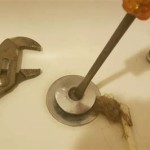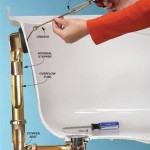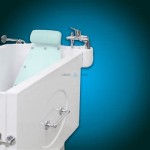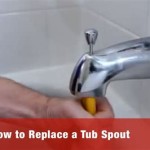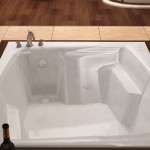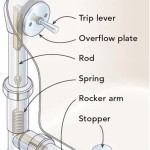How To Attach a Garden Hose Bathtub Faucet Adapter
Connecting a garden hose to a bathtub faucet can be a practical solution for various tasks, from filling large containers to washing pets indoors. However, standard bathtub faucets are not designed to directly accommodate garden hoses. A garden hose bathtub faucet adapter bridges this gap, allowing for a secure and leak-free connection. This article details the necessary steps to successfully attach a garden hose bathtub faucet adapter.
Before initiating the process, it’s crucial to understand the components involved. The adapter typically consists of a threaded connection that screws onto the faucet and a male hose thread to which the garden hose attaches. Adapters are available in various materials, including brass, plastic, and chrome. Brass adapters are generally more durable and resistant to corrosion, while plastic adapters are a more economical option. Chrome adapters offer a better aesthetic appeal, especially when matching existing bathroom fixtures. Identifying the appropriate adapter for the specific faucet type is a critical first step.
The process necessitates a few essential tools and materials. A garden hose, a garden hose bathtub faucet adapter, a rubber washer or Teflon tape, and adjustable pliers or a wrench are typically required. It is essential to have a sufficient amount of Teflon tape to ensure a watertight seal if a rubber washer is not available. The presence of a rubber washer often negates the need for Teflon tape, but it’s beneficial to have both on hand.
Key Point 1: Preparing the Faucet
Prior to attaching the adapter, the existing faucet should be properly prepared. This involves removing any existing aerators or attachments from the faucet spout. Most bathtub faucets feature a screw-on aerator that can be removed by hand or with adjustable pliers. Applying moderate pressure is crucial to avoid damaging the faucet finish. Wrapping a cloth around the faucet while using pliers can further prevent scratches or marks.
Once the aerator is removed, inspect the faucet threads for any debris, mineral buildup, or corrosion. Accumulated debris can hinder the adapter from seating correctly, leading to leaks. Clean the threads thoroughly using a small brush or a cloth. For stubborn mineral deposits, a diluted vinegar solution can be applied and left to soak for a few minutes before scrubbing gently. This process effectively loosens the buildup, allowing for easier removal.
After cleaning, ensure the faucet threads are dry before proceeding. This is particularly important if using Teflon tape as the primary sealant. A dry surface allows the Teflon tape to adhere more effectively, creating a more robust seal. A clean and dry faucet thread is a prerequisite for a successful and leak-free connection.
Key Point 2: Installing the Adapter
The installation of the adapter involves two primary methods of sealing the connection: using a rubber washer or applying Teflon tape. The choice depends on the adapter's design and the user's preference. When using a rubber washer, ensure it is properly seated inside the adapter's female threaded end. The washer should fit snugly against the faucet's threads, providing a watertight seal when tightened.
If relying on Teflon tape, wrap it around the faucet's threads in a clockwise direction, when viewed from the end of the faucet. Applying two to three layers of Teflon tape is usually sufficient. Overlapping each layer slightly ensures complete coverage and enhances the sealing capability. Avoid applying excessive Teflon tape, as this can create a bulky connection that may not tighten properly.
Once the washer is in place or the Teflon tape is applied, carefully screw the adapter onto the faucet threads. Turn the adapter clockwise, applying gentle pressure to ensure it aligns correctly. Avoid cross-threading, which can damage both the adapter and the faucet threads. If resistance is encountered, back off the adapter and re-align it before proceeding. Hand-tightening the adapter is typically sufficient for the initial connection.
After hand-tightening, use adjustable pliers or a wrench to further secure the adapter. Wrapping a cloth around the adapter, as before, helps to prevent scratches. Apply only slight additional pressure when tightening. Overtightening can damage the adapter or the faucet threads, potentially causing leaks or even cracking the faucet. The goal is to achieve a snug fit that creates a watertight seal without stressing the components.
Key Point 3: Testing for Leaks and Ensuring Proper Function
Following the adapter’s installation, it's imperative to test for leaks. Connect the garden hose to the adapter and turn on the faucet to a low flow rate. Carefully inspect the connection points between the adapter and the faucet, as well as between the adapter and the garden hose. Look for any signs of water leakage, such as drips or seepage.
If leaks are detected, first try tightening the adapter slightly with the pliers or wrench. If the leaks persist, shut off the water supply and detach the adapter. Inspect the rubber washer for damage or misalignment. If using Teflon tape, reapply a fresh layer, ensuring proper coverage and adherence to the threads. Reattach the adapter and repeat the tightening and testing process.
In some cases, leaks may stem from damaged or worn garden hose connections. Inspect the hose's female connector for any cracks or deformities. Replacing the hose’s washer or, if necessary, the entire hose can resolve this issue. It is also possible the adapter itself has a manufacturing defect. A replacement adapter will be required in that case.
Once the connection is leak-free, gradually increase the water flow to ensure the adapter can handle higher pressure without leaking. Observe the connection points closely for any signs of stress or instability. If the setup remains secure and leak-free at higher flow rates, the installation is successful. The garden hose can then be used for its intended purpose.
Regularly inspecting the adapter and hose connections is advisable, particularly after prolonged use. Over time, the rubber washer may degrade, or the Teflon tape may lose its effectiveness. Periodically tightening the connections and replacing worn components can prevent leaks and ensure the continued functionality of the setup. Proper maintenance helps prolong the lifespan of the adapter and the garden hose.
Furthermore, consider the water pressure within the plumbing system. Excessively high water pressure can place undue stress on the adapter and hose connections, increasing the risk of leaks or damage. If the water pressure is known to be high, installing a pressure regulator on the main water line can mitigate this risk and protect the plumbing fixtures. Consult a qualified plumber for advice on managing high water pressure.
Finally, when disconnecting the garden hose, always turn off the water supply first. This prevents water from spraying out and potentially causing damage or inconvenience. Carefully detach the hose and inspect the adapter and faucet threads for any signs of wear or corrosion. Store the adapter in a dry place to prevent rust or degradation. Following these simple precautions helps maintain the integrity of the adapter and extends its usability.

How To Attach A Garden Hose Kitchen Faucet Easy Diy

How To Attach A Garden Hose Kitchen Faucet Easy Diy

Garden Hose Adapter Quick Connect Swivel Easy Installation Temu

Rinseroo Tub Faucet Hose And Sprayer Slips On To Spout For Hair Washing Baby Or Dog Bath Bathtub Showerhead Attachment Shower Adapter Fits All Spouts Up

No Shower Problem Install A Diverter In 1 Hour The Art Of Doing Stuff
Can You Attach A Garden Hose To Bathroom Faucet Quora

Garden Hose Adapter For Bathroom Faucet Faucets Sink

Rinseroo Tub Faucet Sprayer Attachment Slip On Dog Shower For Bathtub Pet Adapter No Install Showerhead Attaches To Spout Com
Bathroom Sink Faucet Snap Adapter Quick Connect To Garden Hose Kitchen

Garden Hose Adapter Quick Connect Swivel Easy Installation Temu

